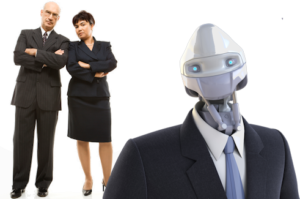Alex Hern (@alexhern) succinctly notes the current state of the debate about artificial intelligence (AI) and robotics and their potential to disrupt the workforce when he writes, “Experts are divided over the role of robots over the next decade, with some arguing that they will create more jobs than they displace, and others worrying that they could lead to income inequality and a breakdown in social order.” [“Will robots take our jobs? Experts can’t decide,” The Guardian, 6 August 2014] The only thing that experts seem to agree on is the inevitability that some jobs, especially those involving repetitive actions, are going to be automated. Change is coming and the effects of that change are going to be painful until the human job landscape transforms dramatically. In fact, Chen Chia-Lun reports, “A recent study showed that by 2030, 50% of jobs today will no longer exist, thanks to artificial intelligence. Yet there is no need to be pessimistic, as according to one study, ‘jobs will evolve’ too.” [“50% of jobs to vanish in 15 years: research,” Want China Times, 15 November 2014] The big question is: Can enough jobs be created in a transformed business landscape to account for all the jobs that will be lost to robots? In part 1 of this two-part article, I’m going to lay out the dark picture that some analysts are painting about the future. In the second installment, I will discuss what some of the more optimistic pundits are saying can be done to create a much brighter future.
Boston Consulting Group (BCG) analysts Alison Sander (@alison_sander) and Meldon Wolfgang write, “When people think ‘robots,’ they often envision vaguely humanoid sci-fi-movie beings with strange speech patterns. But today’s state-of-the-art robots are a far cry from that outdated stereotype. And they are showing up for work. Increasingly flexible, responsive, sensing — even humanlike — robots are beginning to augment and replace labor in a wide range of industries: a megatrend that is transforming the economics of manufacturing and reshaping the business landscape.” [“The Rise of Robotics,” bcg.perspectives, 27 August 2014] Nick Heath (@nickjheath) describes the dark picture that some people, like economist Erik Brynjolfsson (@erikbryn), paint of the future. “Erik Brynjolfsson,” he writes, “has a dream of the future. Or perhaps more accurately, a nightmare. A vision of a world where computers entrench the power of a wealthy elite and push the majority into poverty. A world where the rising tide of technology doesn’t lift all boats, but sucks under all but the biggest ships.” [“Why AI could destroy more jobs than it creates, and how to save them,” TechRepublic, 18 August 2014] Brynjolfsson is not alone. “Tyler Cowen, the economist author of Average Is Over, sees a somewhat permanent employment underclass emerging from the automation of jobs. About 85% of the U.S. population, he argues, will be the victims of slow wage growth and difficulty in making ends meet. There will be much more leisure, but not much money to support it. He expects that many of the less advantaged will move to cheaper places to live in the U.S. heartland. In short, he doesn’t think much can be done about the automation problem other than adjusting one’s lifestyle to it. It’s a pragmatic perspective, but a somewhat depressing one.” [“Can the Automation Tidal Wave Be Resisted?” by Thomas H. Davenport, The Wall Street Journal, 15 October 2014]
Hern reports that when Pew Research “surveyed almost two thousand individuals with expertise in artificial intelligence (AI), robotics and economics, to find out their predictions for the role of automation between today and 2025. The experts were almost perfectly split, with 52% predicting an optimistic path, and 48% worrying about the future.” Let’s face it; it will take a lot more thought and work to achieve the optimistic view of the future than it will to succumb to the dark picture painted by Brynjolfsson. The following video lays out the dark future in an entertaining but alarming way.
Companies that are considering automating jobs that now performed by humans must surely realize three things: First, the ultimate success of their business relies on global economic growth. Second, global economic growth relies on the continued emergence of a middle class that has expendable income and is willing to spend it. Third, the global middle class won’t emerge if good paying jobs are not available because they have all been filled by robots. In other words, many companies could be cutting off their noses to spite their faces by replacing humans with robots. The question remains: Can anything be done to break this vicious circle or to mitigate its effects?
In a follow-on article, Davenport, a professor at Babson College, worries that too many people have blind faith in the fact that technology will create as many jobs as it destroys. As an example of such blind faith, he cites the recent announcement by Infosys Ltd. that it is going to push into the area of artificial intelligence but that as it transforms it is going to do so in such a way that no jobs are lost. Davenport is skeptical that Infosys’ new CEO, Vishal Sikka, can pull it off. [“The Problem With Blind Faith in Technology and Job Creation,” The Wall Street Journal, 22 October 2014] Before explaining why he is skeptical, he quotes a statement that Sikka made in a press release announcing Infosys’ intentions to pursue artificial intelligence. Sikka said:
“The Industrial Revolution was supposed to take away all the jobs and the steam loom was going to make people irrelevant and the sewing machines were going to take our handiwork away — it never happens. Everything about our world has become more productive as a result of technology but that has, in the grand scheme of things, nothing to do with employment.”
Davenport writes, “This extremely high level of faith in technology-fueled job creation is interesting, but I don’t think it stands up to serious examination.” He provides three reasons that Sikka could be wrong. First, “the fact that lost jobs were eventually replaced by new ones in the past does not mean that they will continue to be replaced in the future.” That’s a fair criticism. We all know that you can’t extrapolate the future from the historical past. Second, “even if jobs will eventually be replaced ‘in the grand scheme of things,’ that doesn’t mean that a lot of people won’t suffer.” Change is never easy and never fair (at least in the eyes of those whose lives are most significantly affected). Finally, “Mr. Sikka clearly doesn’t believe his own comment that technology-driven productivity has ‘nothing to do with employment,’ because Infosys itself is planning a major training effort to ensure that its own employees don’t lose their jobs in its movement toward automation and design technologies. That’s a good idea, but it also suggests an implicit belief that new technologies can have significant effects on employment.” The last point is probably the most profound. It takes time to train displaced workers and that training can’t commence until specific jobs are available for which such training can be designed. If and when the jobs do become available, chances are they will be located in areas other than those where displaced workers currently live. Few unemployed workers have the assets necessary to relocate in order to accept a new job. That’s why it will take a lot of thought and a lot of work to pursue the optimistic path with the least amount of pain. The Pew Research survey notes, “A number of the respondents warned that this aspect of technical evolution will lead to vast increases in income inequality, masses of people who are effectively unemployable and the possibility of breakdowns in the social order.” Hern adds, “Almost all of the respondents are united on one thing: the displacement of work by robots and AI is going to continue, and accelerate, over the coming decade. Where they split is in the societal response to that displacement.”
“For many of us trying to navigate the 21st century,” writes Glenn MacDonald, “it’s become sensible — healthy, even — to maintain a simmering, low-grade paranoia about the impending robot revolution. Advances in automation and robotics are impacting virtually every area of technology and industry. We humans seem to be doing everything we can to ensure that the robotic takeover goes smoothly and with minimum resistance. It’s unnerving, really.” [“The robots are coming to steal your job,” CIO, 22 October 2014] As noted above, in Part 2 of this article, I’ll write about some of the things that can be done to increase the odds of maintaining jobs for human workers.




